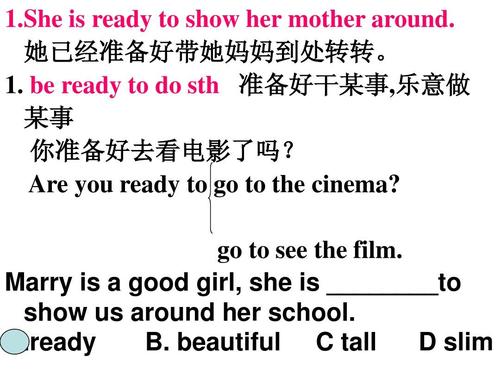一、求解get ready for ,get ready to,be ready for的区别?
①
be ready for和get ready for的区别:使用场合不同、意思不同、用法不同
1.使用场合不同
1.be ready for
解析:be与介词或副词连用,可以表示“位于,在(某处)”“(在某时或某地)发生”“留在(某地);逗留”“出席;到场”等。
2.get ready for
解析:get是英语中使用最广泛的动词之一,可表示“得到某物”“到达某地”“处于某状态”,还可表示“记住”“抓住”“打击”“击中”“杀死”“使受伤”“感染上(疾病)”“难住”“吃”“准备(饭)”“注意到”等多种意思,可用作及物动词,也可用作不及物动词,还可用作系动词。
2.意思不同
1.be ready for意思:v.预备好
2.get ready for意思:v.作准备
3.用法不同
1.be ready for用法:在句中多用作表语,基本意思是“准备”,指某人做某事之前已有所准备; 也可作“乐意的,情愿的”解,指人决心做某事。
例句:
I think he would be ready for anything.
我认为,他将做好一切准备。
2.get ready for用法:在句中用作表语时其后可接动词不定式(不接动名词),也可接介词短语。
It took her a long time to get ready for church
她花了很长时间才做好去教堂的准备。
②
意义上没有区别但是后面跟的内容有区别
be ready for /with sth 愿意做某事
be ready to do sth/be ready for sth 准备好做某事
get ready to后面加动词原形 也就是get ready to do sth.
get ready for后面加ING格式或者名词 也就是get ready for doing sth.或者get ready for sth.
二、lead的用法及短语?
用作动词,主要表示“带领”“引导”“领导”“导致”等,使用时注意以下句型和结构:
1. 表示把某人带到或领到某地,通常用“lead+sb+介词短词或副词”结构。如:
He led the guests into his room. 他把客人带到了自己的房间。
He led us out into the grounds.
他领我们进了庭园。
She led the horse back into the stable.
她把那匹马牵回了马厩。
I tried to lead the discussion back to the main issue.
我试图把讨论引回到主要问题上。
After a while I led the conversation around to her job
过了一阵子,我把话题引到她的工作上。
He took Dickon by the hand to lead him into the house
他牵着迪康的手把他领进屋。
A local peasant led the soldiers through the forest. 一位当地的农民领着士兵们穿过森林。
2. 表示使(导致)某人做某事(有时含有误导之意),通常用 lead sb to (do) sth。如:
What led you to this conclusion? 你是怎么得出这个结论的?
He led me to believe that he had a lot of influence. 他让我相信他很有影响力。
Her constant lying led me to distrust everything she said. 他经常撒谎,我完全不相信她的话了。
What led you to this conclusion?
你是如何得出这个结论的?
His abhorrence of racism led him to write The Algiers Motel Incident
对种族主义的憎恨促使他写了《阿尔及尔汽车旅馆事件》一书。
Mother had led me to believe the new baby was a kind of present for me
母亲让我相信新出生的宝宝是给我的一个礼物。
有时lead to 表示“导致(某种结果)”。如:
Smoking cigarettes leads to lung disease. 抽烟会导致肺部疾病。
Eating too much sugar can lead to health problems.
食用过多的糖会引起健康问题。
Ethnic tensions among the republics could lead to civil war
共和国之间紧张的种族关系可能会引发内战。
3. 表示领导或带领某人做某事,通常用 lead sb in (doing) sth。如:
He’ll lead the party of scientists (in) going to Paris. 他将带领这些科学家去巴黎。
Our Party leads us in building socialism.=Our Party leads us in the building of socialism. 党领导我们建设社会主义。
4. 表示过着某种生活,一般用 lead a…life。如:
lead a quiet life/a life of luxury/a miserable existence
过宁静 / 奢侈 / 悲惨的生活
She led a rather hard life. 她当时过着相当艰苦的生活。
He decided to lead a new life. 他决定要过新生活。
5. 表示通向某地,一般用 lead to,可用于本义和引申义。如:
All roads lead to Rome. 条条道路通罗马。
This road leads to wealth. 这是一条致富路。
比较:This door leads into the garden. 此门通往花园。
~ from/to sth (to/from sth)
(与…)相连,相通
The wire led to a speaker.
这电线连接着扬声器。
Which door leads to the yard?
哪扇门通向庭院?
The track led us through a wood.
我们沿着那条小道穿过了树林。
三、an后面可加哪些单词?
1.applen. 苹果,苹果树,苹果似的东西2.orangesn. 柑桔,橙子(orange复数形式)n. (Oranges)人名;(西)奥兰赫斯;(意)奥兰杰斯3.artistn. 艺术家;美术家(尤指画家);大师4.icen. 冰;冰淇淋;矜持;(俚)钻石vt. 冰镇;结冰vi. 结冰adj. 冰的5.englishadj. 英文的;英国的;英国人的n. 英语;英文;英国人;英格兰人vt. 把…译成英语
四、begin doing和begin to do的区别?
首先,begin doing表示开始做某事,开始正在做的事情,是进行时,谓语动词要用ing的形式,其次begin to do 表示的是开始去做某事,是还没有做,要去做,是将来时,谓语动词要用原形结构,二者虽然有相同的单词,但是在句子中有着截然不同的意思,根据语境判断来选择合适的句子。
、begin to do sth是开始打算要做某事,是指事情还未做,准备开始做;begin doing sth 是指开始做某事,表示动作正在进行。
2.谈及一项长期活动或开始一种习惯时,使用doing.
3.begin, start用进行时时,后面动词用不定式to do
4.在attempt, intend, begin, start 后接know, understand, realize这类动词时,常用不定式to do.
③
一般来说,begin doing和begin to do可以互换.但以下情况通常要用 to do形式:
1. 主语不是指人,而是it等.如:It began to rain.
2. begin后接表示心理活动的词.如:begin to know believe, wonder, think等.
另外,如果谈论一个长期的习惯动作开始养成时,更加常用begin doing.例如:
How old were you when you first began playing the piano?
④
begin doing 和 begin to do 的区别在于 begin 的动词词性(及物/不及物)。begin doing 中的 begin 是及物动词,后面接名词或者名词性的词组,表达“开始某件事”;begin to do 中的 begin 是不及物动词,与后面的动词不定式组成复合谓语,表达“开始(做)某事”。前者用的是动名词形式,后者用的是动词。这两个表达方式从语义上说差别不大,但前者强调“做某事”这件事,后者则表达“做某事”这个行动。比较:The earlier you begin learning English, the better. (强调“学英语”这件事,越早越好。learning English 指学习的过程。)I began to learn English last week. (说的是“学英语”这个行动,强调“开始做某事”,动作意味浓厚。)
五、英语名词后面加什么词?
这个问题有多种可能。
名词可以充当主语,主语后面可能是介词短语等后置定语,也可以是动词做谓语。
名词充当宾语时,后面可以是介宾短语或副词做状语。
六、and做连词时,前面一定要加逗号吗?
“and”这个词用法比较灵活, 首先: and 是连词为什么有时看英语文章时在它的前面要加逗号? and"是并列连词,它前后连接两个相同的语法成分,如动词,名词,形容词,甚至是句子。
如: i'll go to school and study hard. i will call on a friend,and we'll go to museum together. 通常来说,“and"前后连接两个相同功能的词时,前面不加逗号;而连接两个独立的句子时,前面有逗号隔开。
第二:还有就是and在连接两个不定式是后一个不定式是否要省略to 这是肯定的,"to"当不定式符号时,后一个动词一定省略不定式符号“to" 如: we'll intend to go home together and play CS. 这个“TO"就是不定式符号,play 前面绝对不能再出现TO,这是固定的语法习惯,记住就可以了。

